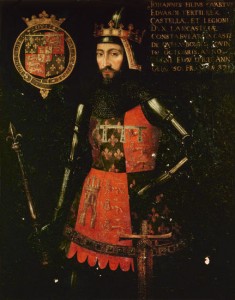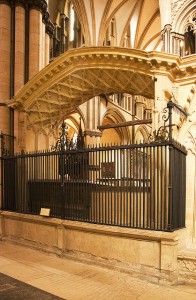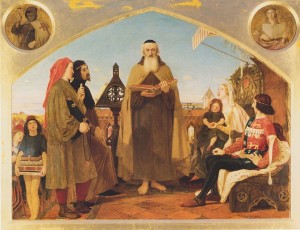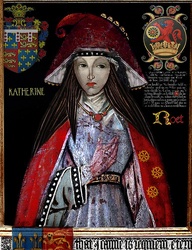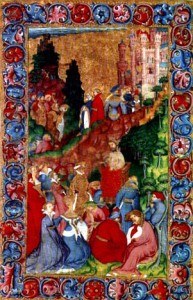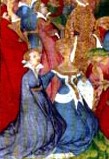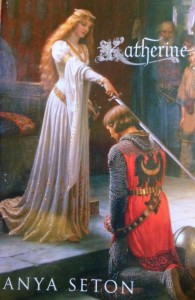What can we say about the Face and Figure of Katherine Swynford, eventually Duchess of Lancaster. What did she actually look like?
Katherine de Swynford might be the most well known, and perhaps the most well-loved, by readers of historical fiction, of all medieval mistresses, but what did this elusive woman actually look like? Some historical figures, particularly from the Tudor era, are easily recognisable. Would we recognise Katherine de Swynford if we passsed her in the street?
The documentary evidence for Katherine’s life is limited to sparse entries of gifts made to her in John of Gaunt’s Register and the writings of monks and clerics who were far more interested in her scandalous behaviour and sinful life than in her appearance. It is possible to glean some thoughts about her character, but nowhere is there any comment on her appearance.
With John of Gaunt there is, of course, no difficulty in imagining this powerful Plantagenet prince. This famous portrait is not contemporary, but still it is thought to be a copy of one that existed from his lifetime. It gives us an excellent and detailed idea of his stature and features, and certainly his pride. There are also written contemporary comments on his appearance at different stages in his life.
But what of Katherine?
The memorial brass on Katherine’s tomb in Lincoln Cathedral is not helpful. There she lies with her head on a pillow, hands together in prayer, wearing the veil of a widow, a simple robe and a cloak. It does not give us much of a clue. Nor is it a medieval. The brass on Katherine’s tomb was destroyed in 1644 and the present one created from a description of the original. Like many medieval brasses or memorials, it shows no definite facial features.
In their memorials, women were invariably shown as the epitome of slim, serene, attractive womanhood. The memorial to Philippa of Hainault in Westminster Abbey is unusual and remarkable for its honesty, as Philippa herself wished. Katherine’s brass follows the usual uniform trend of telling us nothing of her true appearance.
This is a painting by Ford Madox Brown, one of the 19th century Pre-Raphaelite brotherhood, in which the main figure is john Wycliffe, reading his translation of the Bible. Chaucer is obviously there, and so is John of Gaunt, but if the female figure with the child is Katherine with one of her Beaufort children, probably the eldest, John, she has been pushed into the back ground as a pale figure and just a ‘woman in the audience’. Clearly the artist was not interested in her.
The man in the red hood is Geoffrey Chaucer, who was part of the Lancaster household and married to Katherine’s sister Philippa.
So can we do any better for Katherine?
This image is clearly labelled Katherine de Roet, but it is a frivolous twentieth century image with no claim to correctness of either appearance or clothing. What a strange hat she is wearing. It has no authenticity, and should never be labeled as Katherine Swynford.
But we can probably do better.
Perhaps the nearest we can get to catching a glimpse of the real Katherine is from the Frontispiece of Chaucer’s work Troilus and Criseyde.
Produced in early 15th century, it looks back and depicts Chaucer reading to the major figures of the reign of Richard II. There is Richard in dull gold in the centre, his face rubbed out, and beside him in pink Anne of Bohemia, his first wife.
But at the front of the gathering …
Is this a little family group at the front of the illustration on the left? It has been suggested that John of Gaunt is the impressive figure in red. In front of him are two kneeling women On the right of the pair – is this Katherine herself as Duchess of Lancaster, splendidly dressed in Lancaster colours of blue and white, trimmed with fur and gold and wearing a ducal coronet? She is turning with arm outstretched to the younger woman, also dressed in blue. Might this be her daughter Joan Beaufort?
I like to think so.
(It has to be said that the lady in blue and gold and fur has been identified as Joan of Kent but there is as little evidence for this. It is far more likely to be Katherine in company with John of Gaunt.)
Except that perhaps the evidence is weighted in favour of the elusive Katherine. This manuscript has an interesting history. It is said to have been made a few years after Chaucer’s death, perhaps for Joan Beaufort who was of course Chaucer’s niece, for it was later recorded to be in the possession of Joan’s daughter, Anne Neville, Countess of Stafford. If it had been commissioned by Joan, then she and her mother might well have taken centre stage with her father in this family group. Joan was strongly of the mind to reinstate her mother into respectability.
There is no definitive evidence but if this is so, then we can at last make some comment on Katherine. She has a round face, a long, slender and very elegant neck. Her figure is well developed, even voluptuous, as it might be after her years of childbirth, and her hair is very fair. A comely woman indeed, as she must have been to take John of Gaunt’s eye and keep it for all the years of their life together. Royal Dukes did not marry their mistresses, yet John loved Katherine enough to wed her and restore her to the respectability she forfeited when she became his mistress. She must have had something to take the eye. This lady, by now in her forties but still very attractive, might just be Katherine de Swynford.
So since we know so little about Katherine, what do editors do when considering book covers? They have of course to make the most of romantic and chivalric images. This can be best seen with the various printings of ‘Katherine‘ by Anya Seton.
This is the very familiar pre-Raphaelite style painting, The Accolade by Edmund Blair Leighton, which was used for my own Hungarian printing of Virgin Widow, and by other historical writers over the years.
It is beautifully romantic, even though it bears no similarity with any scene either in Katherine’s life of that of Anne Neville in Virgin Widow.
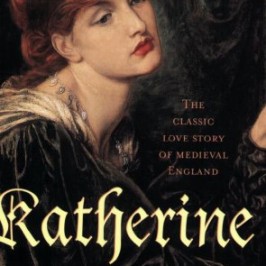
This is Veronica Veronese by Dante Gabriel Rossetti, another glorious Pre-Raphaelite portrait. The woman does not look medieval but does it matter? She is beautiful and emotional and highlights the mood of the novel. What would we do without the romantic Pre-Raphaelites?
